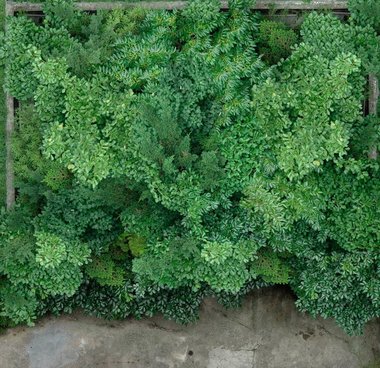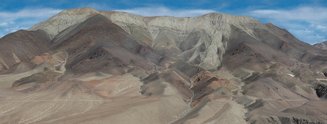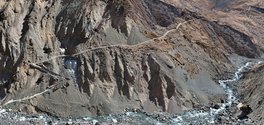John Hurrell – 19 August, 2010
In this exhibition it is an image of a green bush, A Garden, with tiny-leafed yellow-tinged foliage that intrigues with its odd digitally forced rhythms. It is set in some sort of concrete bunker with a wide doorway and the parsleylike form seems a very subtle variation of the grotesque, such are its peculiar, vaguely patterned morphological properties with repeating shaped edges and darkened gaps.
Jae Hoon Lee is well known for his digitally enhanced, highly fanciful landscape photographs and inventive videos where loops of leaf and stem patterns or varieties of human skin - often tattooed - morph into startlingly unexpected permutations.
Some of his earlier images have a bizarre awkwardness that reminds me of angular Chinese rocks or strangely poised Ming trees. They are deliberately unbalanced in the sense of being compositionally top heavy with a strong sense of the teetering. Therefore I tend to be drawn to the more holistic works where elements are more evenly distributed.
In earlier shows such images were his grey-blue seascapes that had repeated troughs of delicately coloured curling waves and sprinkled droplets of foam. In this exhibition it is an image of a green bush, A Garden, with tiny-leafed yellow-tinged foliage, that intrigues with its odd digitally forced rhythms. It is set in some sort of concrete bunker with a wide doorway and the parsleylike form seems a very subtle variation of the grotesque, such are its peculiar, vaguely patterned morphological properties with repeating shaped edges and darkened gaps.
Other images like Hajodae, a rocky isthmus which like a Chinese scroll painting has its nearest point at the bottom and its most remote edge at the top, has the oddest perspective that looks as if the distant end is rising up so that the picture plane is tilted - so that the sea and rock are sloping. Again certain parts are regularly repeated or flipped over, such as a splash on the side of one projecting rock. Through this digital method there is an odd stylisation that is obviously not graphic - though there is an appealing hint of it in the flourishes of its ‘mannerism’.
The spatial tilting of the image continues in the two images of Pebble which show a braided river. The shingle banks seem to swell upwards and then flatten out as they recede further away at the top.
One other work still, Mountain, is oddly sensitive in its blended planes of bare rock, so it looks quite painterly and austere, like a symmetrical Bill Sutton watercolour mixed in with a darker Georgia O’Keefe. The huge rocky outcrop looks sculpted, which in a sense it is. It seems carved with a penknife, chunks sliced off at the sides.
Trekking is wilder, showing a winding road on the slopes of Annapurna - a fiddled-with version of that famous mountain in Nepal. The road is like a zigzagging sheep track on scree slopes with an icy mountain stream below it. Some parts are repeated but mostly it lacks the overt artifice of say Hajodae or A Garden. The method seems indecisive and meandering I think - like its subject matter. It seems too realistic without a contrived rhythm. It is not sufficiently extreme.
Ground Zero though is especially worth seeing for the three works I’ve raved about. Mountain, Hajodae and A Garden are not only technically clever but make you think about language, categories and visual classification. About trying to nail verbally a botanical or geological quality, for example, that you detect in different spatial contexts several times because it is also visual. An essence peculiar to photography that you snatch at and miss - despite its repetition - but which repeatedly haunts you and taunts you.
John Hurrell






 Two Rooms presents a program of residencies and projects
Two Rooms presents a program of residencies and projects Advertising in this column
Advertising in this column



This Discussion has 0 comments.
Comment
Participate
Register to Participate.
Sign in
Sign in to an existing account.